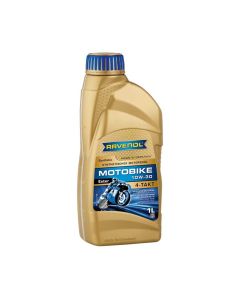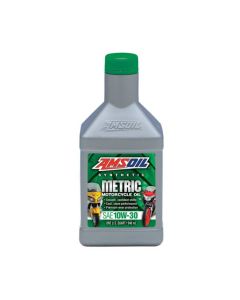10W-30 | Motorbike Engine Oil
-
 RAVENOL Motobike 4-T Ester SAE 10W-30As low as €14.95 As low as €0.00
RAVENOL Motobike 4-T Ester SAE 10W-30As low as €14.95 As low as €0.00- high performance engine oil with ester additives
- semi-synthetic formulation
- API SM and JASO MA / MA2 specification
Buy the right motorcycle engine oil for your machine at low price!
When buying the right engine oil, it basically depends on the same criteria as in the car or in other motor vehicles:
The choice of the right oil is essential. But why is this so?
As in passenger cars, engines are being developed at a rapid pace due to the ever-increasing demand for new performance spheres coupled with requirements for vehicle emission values. The complexity of individual components is increasing and, as a consequence of the rising demands, the combustion engine is becoming more and more technical and precise.
In order to achieve performance and, more importantly, to provide sufficient protection under these conditions, the demands on the lubricants used are also increasing. As a result, motorcycle engine oils are also becoming increasingly differentiated. This is expressed in various specifications, manufacturer approvals and oil manufacturer recommendations.
Motorcycle engine oil - What are the differences?
Also with the motorcycle the question arises with the multiplicity at engine oils on the market and in on-line Shop of ATO24 justifiably after the differences.
Why does this engine oil fit my machine but another not?
Why can I use a certain 10W-40 motorcycle engine oil but should not use another?
We explain you understandably the connections:
Differences in the field of application
First of all, motor oils in the motorcycle must be distinguished according to their field of application. Depending on the use or type of machine, the engine oil is used in a completely different temperature range or under changed external influences. This results in the basic distinction:
- Engine oils for motorcross machines
- Engine oils for cruisers
- Engine oils for racing machines
Differentiation according to lubrication system
Furthermore, there are significant differences in the type of engine lubrication. A distinction must be made here between two-stroke engines and four-stroke engines. Thus in motorcycles are found
- 2-stroke engines with mixture lubrication
Oil is mixed directly with the gasoline before refueling. The engine does not have an independent oil circuit. The gasoline-oil mixture is burned during combustion (lost lubrication). - 2-stroke engines with separate lubrication
The engine is refueled with gasoline in the fuel tank and also has a tank for 2-stroke oil. Just as in the case of mixed lubrication, this is loss lubrication - the oil is therefore also burned as it passes through the engine. - 4-stroke engines with their own oil circuit
Modern 4-stroke engines with their own oil circuit come in various forms, such as wet sump lubrication, dry sump lubrication, etc., but what is the actual difference?
But what exactly is the difference? Can I put a 4-stroke engine oil into a 2-stroke engine?
The clear answer is: This should be avoided! If you use an engine oil for 4-stroke engines in a 2T engine, this will cause the oil mixed with the gasoline to burn with difficulty, since an oil for a 4-stroke engine is optimized to achieve a certain evaporation stability. The long-term consequence will be unclean combustion and resulting deposits in the engine and exhaust tract.
Mineral or synthetic - differences in production and composition
Among the motorcycle engine oils are
- Mineral Engine Oils
Known as the "archetype" of engine oil. Are derived from petroleum and alloyed with additives. Often mineral engine oils are prescribed and required for older engines in two-wheelers, as synthetic oils cannot be used. As a rule of thumb, the service life in motorcycles is approximately 5000 km or 1 year. - Synthetic Engine Oils
The basis here is mineral oils, which are synthetically "optimized" by the addition of additives to achieve longer service lives and improved temperature and stability properties, which are a significant improvement not only but especially in air-cooled engines.
Viscosity of motorcycle engine oil
Typical viscosities of motorcycle engine oils are the SAE grades
Harley Davidson, for example, relies in most cases on special SAE 20W-50 engine oils that guarantee long-lasting optimal engine lubrication. Suzuki, on the other hand, usually recommends 10W-40 engine oils, and Kawasaki increasingly relies on 5W-40 engine oil. All these oils are relatively more viscous lubricants, as only these can cope with the stresses at high engine temperatures. New passenger car viscosities such as 0W-16 or 0W-20 will not be found in the 2-wheel sector, as these lubricants are too thin and would lead to increased problems such as clutch slippage.
- 20W-50 Engine Oil for Harley Davidson Motorcycles at ATO24
- 10W-40 Engine Oil for Suzuki Motorcycles at ATO24
- 5W-40 Engine Oil for Kawaski Engine Oil
- BMW Advantec Engine Oils 5W-40 and 15W-50
Specification and release for motorcycle engine oil
As in the other oils for internal combustion engines, the choice of the right engine oil usually depends not only on the viscosity. In parallel, vehicle manufacturers express the required quality of an oil or the technical requirements for the oil in that additional institutionalized specifications or even manufacturer approvals are made a prerequisite.
Specifications according to the European ACEA (Association des Constructeurs Européens d'Automobiles), the international ISO (International Organization for Standardization) and the American API (American Petroleum Institute) are also used for motorcycles, just as they are for passenger cars. In addition, the Japanese JASO (Japanese Automotive Standard Organization) issues specifications specifically for motorcycles. We explain the JASO specifications briefly and concisely:
- JASO MA / MA1
for motorcycles with 4-stroke engine and wet clutch
JASO MA2 - für Motorräder mit 4-Takt Motoren und gesteigerten Drehmomenten
- JASO MB
for motorcycles with 4-stroke engine and dry clutch or separately lubricated transmission - JASO FB corresponds to ISO-EGB
For 2-stroke engines under light operating conditions, mostly mineral engine oil - JASO FC corresponds to ISO-EGC
For 2-stroke engines under medium operating conditions, mostly synthetic oils - JASO FD corresponds to ISO-EGD
For 2-stroke engines under medium operating conditions, mostly low-smoke burning synthetic oils
What are the differences between car engine oil and motorcycle engine oil?
Motorcycle oils are clearly distinguishable from car oils. Basically, the differences lie in the following points:
- Automobiles use different oils to lubricate the engine, transmission and rear axle, respectively. Each of these oils is thus adapted to the individual areas. Motorcycles and mopeds are different. Here, one oil is usually responsible for the lubrication of all components. So there is only one oil circuit! Exceptions are chain oil and fork oil.
- Motorcycle engines run at much higher speeds, about 1.3 times to 2 times higher than passenger cars. Higher speeds also require different properties of the engine oil.
- Modern passenger car engines are water-cooled. Motorcycle engines are also water-cooled in some cases, but often air-cooled as in older passenger cars. In these cases, the engine oil plays an even more important role in cooling the components.
- The relationship between engine displacement and power output is different for passenger cars and motorcycles. Motorcycle engines develop higher power with smaller displacement. In 2-wheel engines, the oil can heat up to 160 °C and must nevertheless ensure optimum lubrication.
Engine oil 10W-30: Large selection, wide range, top prices at ATO24
You are looking for a suitable 10W-30 engine oil for your vehicle? In the online store of ATO24 you are right!
We help you to find out what is important for your vehicle and to buy exactly the right one from our large selection of SAE 10W-30 engine oils. In addition to our competent advice, we offer you attractive prices.
In addition to the engine oil viscosity SAE 10W-40, oils of the viscosity class SAE 10W-30 are among the most demanded engine oils with the cold viscosity 10W. But what exactly does 10W-30 actually mean and why are there so many different oils despite the same viscosity? We will clarify these and other questions in the course of this blog article.
What does 10W-30 mean?
SAE 10W30 is what is known as a multigrade viscosity. Correctly written out as 10W-30, the two viscosity indexes given, 10W and 30, refer to all-season use (suitability for winter and summer use). These multigrade oils were developed over 50 years ago and were intended to replace the procedure of having to change oil at summer and winter time. The viscosity specification in cold (10W) and warm (30) viscosity indicates the flowability of the oil at high and low temperatures.
10W stands for the flowability in winter (this is where the W index comes from). The value 10 is not a directly measurable value of a certain unit but an index number. The lower the number before the W, the better the flowability at cold temperatures and cold starts. A 5W-30 engine oil therefore has better flow properties when cold than a 10W-30 engine oil.
The number 30 stands for the flowability of the oil at a temperature of 100 degrees. Again, the lower the number, the lower the viscosity at a temperature of 100 degrees. Accordingly, a 10w30 engine oil here is comparable to a 5W-30 engine oil.
Buy 10W-30: There is to consider!
Even if the vehicle manual recommends a 10w-30 engine oil, this does not immediately mean that you have found the right 10W30 oil. When buying a 10W-40, attention must be paid to the prescribed specification and approval. They represent the particular chemical properties of an oil.
10W-30 engine oil approvals
As always, your vehicle may require a approval in addition to the 10W-30 viscosity. These approvals are listed on the bottle label next to the specifications. The best known approvals are those of BMW (e.g. LL-04), VW (e.g. VW 507 00) and Mercedes Benz (e.g. MB 251.0). The approvals with the engine oil are comparable with a quality seal of the automobile manufacturers. Thus this manufacturer issues a certain chemical characteristic of oils, which must be fulfilled, in order to be permissible for the cars from the own product series.
What engine oil approvals occur together with viscosity SAE 10W-30? Among many others, common engine oils are of the following clearances and recommendations 10W-30 engine oils:
What is the difference between 10W-30 and 10W-40?
Both viscosities share the "10W" winter property, which means they have the same properties at low temperatures and cold starting. The indices 30 and 40 refer to a difference at high temperatures. Thus, the 10W-40 shows a slightly higher viscosity at high operating temperatures. This difference can be advantageous if the engine has oil losses with a 10W-30 motor oil.





